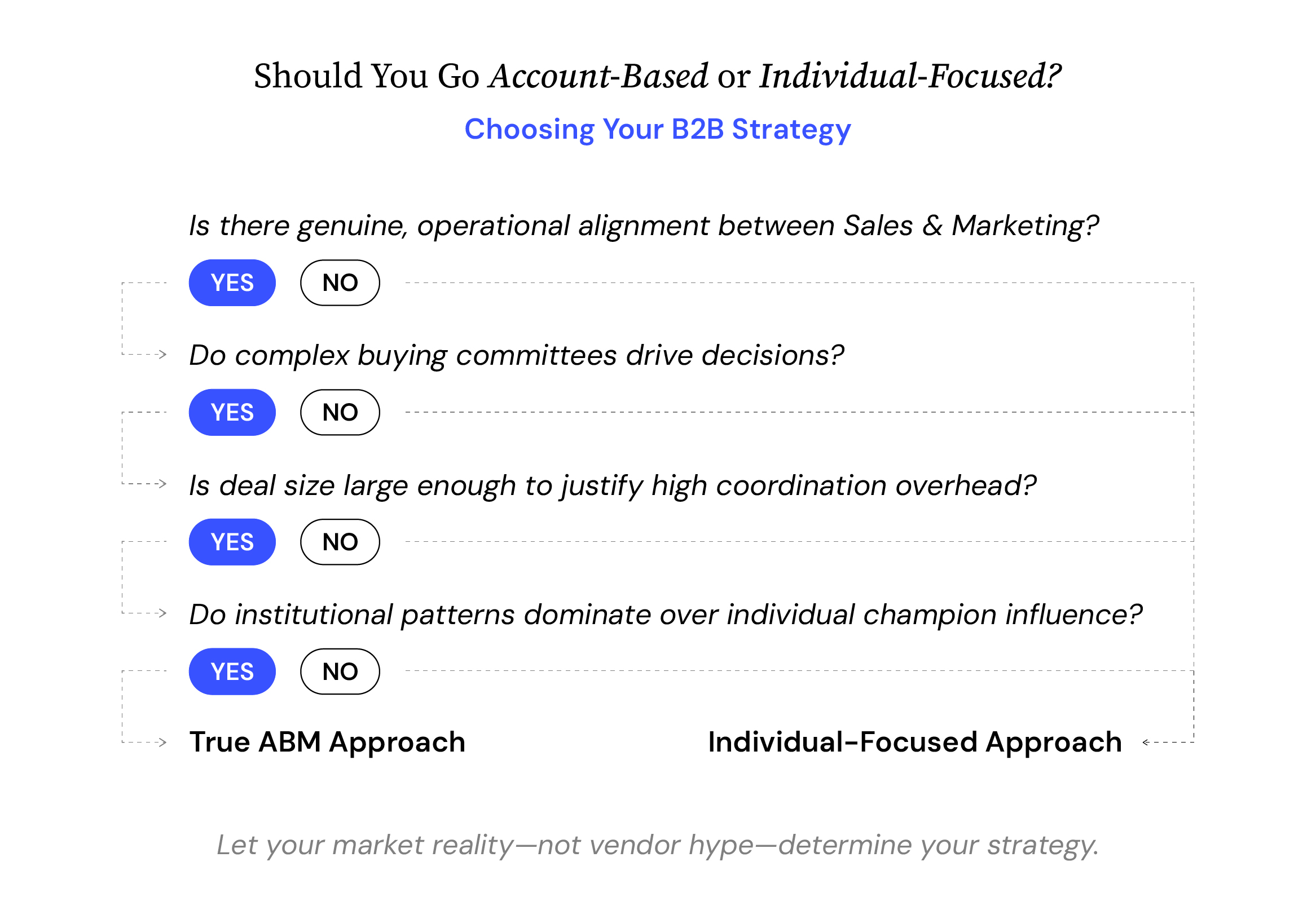Summary
Account based marketing often functions as expensive technology searching for organizational problems that don't exist. Most companies lack the internal alignment required, while individual psychology frequently drives B2B purchase decisions more than account characteristics.
Account based marketing has evolved into an expensive solution searching for problems that don’t actually exist. Most companies lack the internal alignment ABM requires and individual psychology often drives B2B purchase decisions more than account characteristics.
The technology-first trap
Marketing teams implement sophisticated ABM platforms with genuine optimism. Target account lists get created. Intent data flows in. Coordinated campaigns launch across sales and marketing. The dashboards look fantastic.
Six months later, sales teams are still working their own pipeline. Marketing celebrates account engagement metrics while revenue impact remains unclear. The ABM technology works exactly as advertised—but the humans haven’t changed how they actually work.
This is account based marketing’s fundamental flaw: It’s designed to solve organizational problems with technology solutions.
The alignment prerequisite nobody mentions
Vendors selling account based marketing strategy solutions often gloss over the business transformation required. True ABM demands organizational changes most companies aren’t ready for:
- Shared accountability where sales and marketing genuinely succeed or fail together
- Unified planning that actually influences resource allocation decisions
- Consistent messaging across every touchpoint, including unscripted sales conversations
- Resource prioritization focused on account potential rather than individual opportunities
Working with a quality engineering company during market expansion, we watched this reality play out. Marketing invested heavily in ABM technology and created detailed account research. Sales teams attended training, nodded appreciatively, then continued prospecting exactly as before.
The platform generated impressive activity reports while sales maintained their existing approach. Technology couldn’t bridge the organizational gap between marketing planning and sales execution.
The individual psychology factor
Here’s where account based marketing orthodoxy encounters an inconvenient truth: B2B purchase decisions often depend more on individual motivations than account characteristics.
Working with a multi-experience development platform, ABM logic suggested targeting based on company size and industry vertical. But conversion analysis revealed something different:
- Technical architects frustrated with development complexity converted regardless of company size
- Innovation managers seeking career advancement responded independent of industry vertical
- Operations leaders under efficiency pressure engaged based on personal pain points, not organizational strategy
When we shifted from account targeting to individual psychology, engagement rates improved significantly. Personal motivations mattered more than employer characteristics in driving the actual b2b purchase decision.
The measurement mirage
ABM success metrics often create the illusion of progress while obscuring poor performance. Account engagement statistics look compelling but don’t correlate with revenue outcomes.
A sustainable mobility platform demonstrated this gap perfectly. ABM dashboards showed strong account engagement, but qualified opportunities came from individual-focused campaigns addressing specific professional motivations—workflow efficiency frustrations, access problems, validation needs—rather than account-based messaging.
When ABM actually works (and when it doesn’t)
ABM makes sense when:
- Your organization has genuine sales-marketing operational alignment
- Complex buying committees drive decisions more than individual champions
- Deal sizes justify coordination overhead
- Institutional decision-making patterns dominate.

Individual-focused approaches often outperform when:
- Personal psychological triggers drive decisions more than organizational factors
- Individual champions influence purchases more than committee consensus
- Professional motivations outweigh institutional strategic priorities
- Your go to market strategy needs efficiency over comprehensive account coverage
The strategic reality
Most companies implementing ABM assume account targeting outperforms individual-focused approaches without testing this assumption. They invest in sophisticated technology to solve coordination problems that require organizational change, not marketing tools.
The solution isn’t abandoning account strategy—it’s applying strategic intelligence about when account-based approaches make sense versus when individual psychology matters more in your specific marketing strategy.
Organizational readiness, actual decision-making patterns, and resource constraints should determine approach, not vendor positioning or conference presentations about best practices.
The uncomfortable truth
Account based marketing has become an expensive technology solution that promises to solve complex business problems through better targeting and coordination. But most organizations lack the internal alignment required, and many B2B purchase decisions are driven by individual psychology rather than account characteristics.
Instead of defaulting to ABM everything, consider whether your prospects make decisions as representatives of their companies or as individuals solving personal professional problems. This insight should fundamentally shape your go to market strategy and technology investment priorities.
Key Takeaways: Account-based marketing (ABM) often falls short because it requires deep organizational alignment, yet most companies lack the internal coordination to execute it effectively, and engagement metrics can mask weak revenue impact. A more effective B2B marketing strategy comes from balancing account-level targeting with individual psychology and applying selective, evidence-based approaches rather than rigid ABM best practices.






